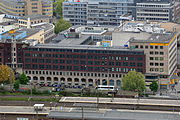Essen main post office
The listed building of the main post office in Essen is located in Essen city center on Hachestrasse, at the corner of Willy-Brandt-Platz.
history
Main Post Office on Burgplatz (until 1902)
Until the opening of the new building at the main train station in 1903, the old main post office in Essen was located at Burgplatz 1 and 2, where the Lichtburg is today. There was also Amt 2 at Limbecker Platz 3 and Amt 3 at Schützenbahn 56.
The old main post office building in the classicism style was originally a house of the Essen monastery , which also bore the names Der Rittberger Hof and Das Löwenhaus . From 1821 to 1862 it was the location of the Royal Mining Authority , with its director, Oberbergrat Heintzmann, living on the first floor. Then the post office and the telegraph office moved in here. The rooms soon proved to be inadequate, so that the rooms in the neighboring school building to the east were also used. In the autumn of 1901, the telephone company moved into a temporary building in the courtyard of the new post office building that was currently under construction on Märkische Strasse at the main train station, now Hachestrasse. In 1903 the entire postal service followed and moved into the new building there. After renovation in 1904, the municipal museum moved to the first floor of the former post office building on Burgplatz, until the building had to give way to the new Lichtburg cinema, which opened in 1928.
Building at the main train station (1903–1932)
The first post office at today's location, a former property of the industrialist and patrician family Waldthausen - on the corner of Kettwiger Strasse and Märkische Strasse opposite Essen Central Station , today Hachestrasse - was built in the neo-Gothic style with a corner tower between 1900 and 1903 . In addition to the postal service, the telegraph and telephone exchanges were also located here. The post office was connected to the main train station via an underground tunnel. In March 1920, part of the Ruhr uprising took place in the post office , when the Red Ruhr Army stormed the building that had been defended by members of the Reichswehr and the Freikorps .
Due to the rapid population increase in the city at the beginning of the 20th century, mainly due to the immigration of workers for the mining and Krupp steel industries, the building quickly became too small. As a result, the Oberpostdirektion Düsseldorf decided to build a new building in the early 1920s. In 1932, when the last construction phase was started, the old post office was demolished.
Main post office today
Today's post office, which opened in January 1933, stands about eight or fourteen meters to the rear compared to its predecessor. As seen from Essen main station, a representative entrance area to the city center was created, called Willy-Brandt-Platz since 1994 and only since then a pedestrian zone. This square is lined with the post office and a department store in the west, the Eickhaus in the north and the Hotel Handelshof in the east. The post office was built in individual construction phases between 1924 and 1933 and was designed by the architect Hoeltz with a clinker and limestone facade as a counterpart to the stock exchange, which is now the House of Technology . The entrance to the street An der Reichsbank , which leads into Essen's old banking district , is covered by a pressed pointed arch.
Even then, the style of the first two construction phases with brick façades was criticized for being out of date. The architect Lindemann then designed the third construction phase in 1930 and 1931 in the New Objectivity style with a shell limestone ashlar facade, which completed the elongated building on Hachestrasse towards today's Willy-Brandt-Platz and opened in January 1933. The entire building complex was badly damaged in World War II and rebuilt in the 1950s.
The building has been a listed building since 1988, so all around 440 wooden windows were renovated by summer 2009.
literature
- Essener Allgemeine Zeitung from April 10, 1931
- Sigrid Watzlawik: Visions in Stone. Modern building in Essen 1910–1930. Nobel / Verlagsgruppe Beleke, Essen 1998, ISBN 3-922785-49-2 .
Web links
- The building in the Essen list of monuments (PDF; 466 kB)
- List of listed buildings of the postal and telecommunications system
Individual evidence
- ↑ a b c Hugo Rieth: Essen in old views, Volume 1 . 3. Edition. Zaltbommel, Netherlands 1978.
- ↑ a b c d Tony Kellen: The industrial city of Essen in words and pictures. History and description of the city of Essen. At the same time a guide through food and the surrounding area. Fredebeul & Koenen, Essen 1902.
- ↑ Holger Krüssmann: Architecture in Essen 1900–1960 . Ed .: Berger Bergmann and Peter Brdenk. Klartext, Essen 2012, ISBN 978-3-8375-0246-6 .
- ^ Essen monument trail ; accessed on May 29, 2015
Coordinates: 51 ° 27 '7.6 " N , 7 ° 0" 45.4 " E




